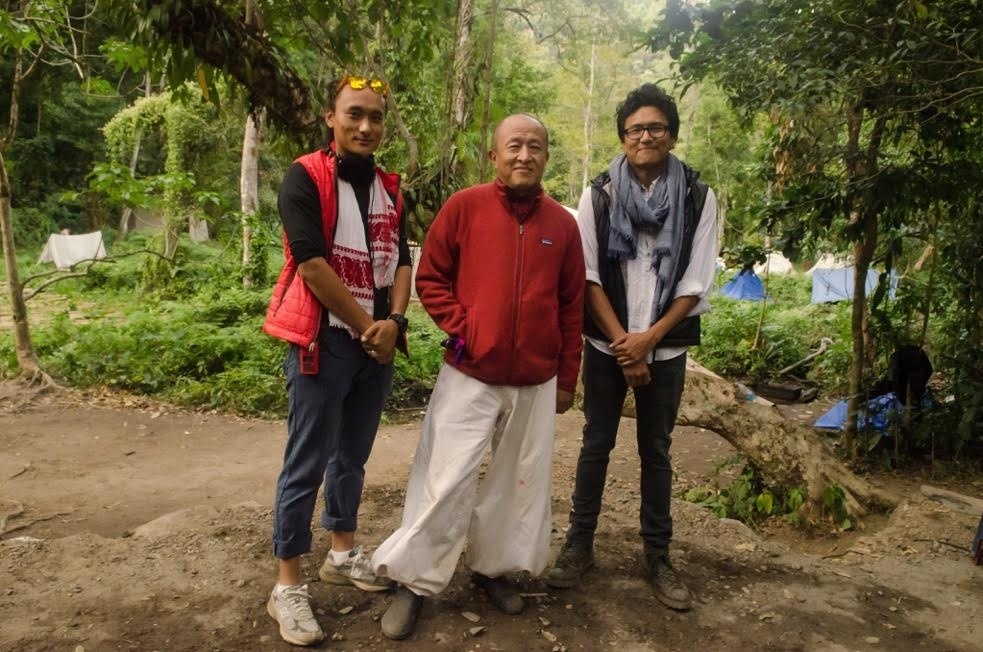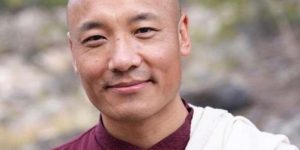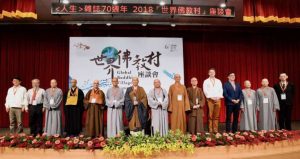
Hema Hema: Sing Me A Song While I Wait is the fourth film by Bhutanese lama and director Dzongsar Jamyang Khyentse Rinpoche. Set in the forests of Bhutan, the movie is an exploration of one man’s journey through the bardo and the choices he encounters there. Pawo Choyning Dorji, a producer of the film and personal attendant to Dzongsar Khyentse Rinpoche, spoke with Buddhistdoor Global writer Harsha Menon about his experiences of devotion, production, and creating art on the Buddhist path.
HM: How did you become involved in the production of Hema Hema?
Pawo Choyning Dorji: First and foremost, my job is to work for Dzongsar Khyentse Rinpoche. I am one of his attendants and I serve him in the best way I can. It’s what you call Guru Shishya—I am a full-time attendant of Dzongsar Khyentse Rinpoche and I try and serve him in different capacities. I help run the Khyentse Labrang (a lama’s home in a monastery and his household) in Bir, India. I also serve in the Khyentse Foundation on the scholarship committee. As an attendant, I have to do whatever the guru wishes, so sometimes I have to be his photographer, sometimes his driver, and sometimes he asks me to produce a movie.
When the plan for the movie started I wasn’t really brought on as the producer, I was actually just serving him as an attendant and doing whatever he needed me to do for the movie, including making sure we found the locations, and finding the right crew and cast. I was basically a liaison between him and other workers. A few months before production had fully started he said to me, “You should produce this movie because you have been involved from the start.” And that’s how I got involved.
For Vara: A Blessing, Rinpoche’s previous film, I was the director’s assistant and stills photographer, so that was really my introduction into the world of filmmaking. Of course, back then I absolutely hated it. Everyone asked me if I was even going to be involved in another movie and I said that I thought this was the most difficult thing to do. I did not want to be involved, and three years down the line the director’s assistant becomes the producer.

HM: What attracted you to the project?
PCD: When you have a spiritual guru, your guru is your world. Everything the guru does, every manifestation, you wish to be a part of it. In a way, I think I am very fortunate that I have a guru like Dzongsar Khyentse Rinpoche—someone who wears different hats and with whom I can connect and relate to on many different levels. I, of course, connect with him and relate to him on the spiritual level, but then also on the non-spiritual level as an inspiring storyteller, myself through photographs and through books I can connect with him, and now even in the filmmaking aspect. I am fortunate that I can still learn from my guru in this aspect as well.
HM: The film was co-produced in Hong Kong. Can you say a little about how that came about and how it worked as a co-production?
PCD: This film is entirely funded by crowdfunding. We had two platforms: one was Kickstarter in America and the other was the Jingdong platform in China, which is the Chinese version of Kickstarter. About 60 per cent of the funding came from the Chinese platform and 40 per cent came from US-based Kickstarter. A lot of our donors came from the Chinese-speaking world—Taiwan, Hong Kong, China—so just to make the flow of funds easier, we decided to start a production company in Hong Kong. Also, a lot of our post-production was done in the Chinese-speaking world. For example, our sound editor was in Taiwan, our film editor was in Beijing, and color correction took place in Beijing as well, so to communicate with them we needed an office in Hong Kong. It was a co-production in that the Bhutan-based production company focused on pre-production, on planning, on production of the movie, and then the Hong-Kong based co-production company focused on post-production.
We really tried to keep this film and story a Bhutanese one, but there were certain areas in which we needed help. One aspect was post-production. There are no post-production houses in Bhutan that can do the work that was required, so sound, color correction, and editing we decided to do outside.

HM: Can you tell us about what your responsibilities were as a producer on the ground?
PCD: Production-wise, finding the locations—that was very important—and making sure we had local support. Given the strictness of Bhutan, getting equipment in, getting the right people in, it’s very challenging. We had to find a place that was remote enough, but also that was easily accessible, so finding the ideal location was a big challenge. Finding the right people is a big task for any producer—making sure you have the right people in every department. From the beginning, in discussion with Dzongsar Khyentse Rinpoche, I had decided that this production would really be done by the youth of Bhutan. I thought it would be wonderful to pair Rinpoche’s vision, Rinpoche’s wisdom, and Rinpoche’s stature in the filmmaking world together with the raw enthusiasm of Bhutanese youth.
You could say that we took a gamble on that and it paid off wonderfully. We had a lot of people involved in the movie who were working for the first time on a film set, for example. And the few foreign crewmembers that we did bring in, their dedication to the project was just so inspiring. The whole crew, local and foreign, came on board for the love of art and filmmaking and not because of financial incentives.
With our more experienced foreign crew, I was careful to tell them that, yes, you are working on a film set, but we also need to be very patient because a lot of people are new and they are here to learn from you. So, yes, you will be working on a film set but you will also be teaching your respective skills to the young Bhutanese team. At the beginning of production we told them that we are going to be going camping, and learning how to make a film, and hopefully at the end we will have something to show the world.

HM: How big was the crew and were they Bhutanese?
PCD: The crew itself was quite small, I would say about 75–80 people. They were almost all Bhutanese, but we did have a few foreigners. For example our soundman was from New York, but now working out of New Delhi. Our gaffer was from New York as well, and our production designer and the assistant production designer, they were from Canada, and our composer was from London.
For these roles we needed to bring people from outside because there weren’t any Bhutanese who were qualified or had the experience to fulfill these roles. But when we did bring them in, we told them that they needed to teach the Bhutanese how to do these responsibilities. It’s very difficult to get equipment in Bhutan, so a lot of our lighting equipment was brought in from India. We had a whole team of lighting crew, I would say about 15 of them.
I think the real challenge was that we had on set more than 400 actors, mostly village people from eastern Bhutan. They were the easiest people to work with because they did not see themselves as acting extras, but as people attending a religious event being organized by Rinpoche. They were so willing to take part and sometimes would get upset if we did not use them enough!

HM: There are efforts to bring more film productions to Bhutan. Can you say a little about your work in this regard?
PCD: I feel that Bhutan really is going through a special phase in the art film industry. We had our world premiere as well as short films being screened in Locarno, and Hema Hema is going to be in competition in Toronto. We are going to the Busan International Film Festival in South Korea, and there are other Bhutanese films going to that festival as well for their world premieres, so it’s a special moment. I think the reason we are going through his moment stems from a decade ago, when we were raw amateurs in filmmaking. We have come a long way, but still at this moment we are not really professional industrial filmmakers.
But this in-between stage is something that I think is so beautiful, because when you are an amateur you’re held back by the fear of failure, and then when you become professional you kind of get weighed down by expectations of success and financial incentives. So Bhutanese filmmakers are right now in this in-between state—between the amateur and the professional. I feel like it is an in-between state in which the filmmakers become curiously fearless in the way they express their stories, which I think is such a special moment and it’s evident that this is happening and the international stage is taking notice of this moment and I feel that’s very special. I feel it’s a moment that all Bhutanese filmmakers right now should be proud to be a part of.
HM: Who is your intended audience and what are your distribution plans?
PCD: It’s no secret that our director’s aspiration is to make a film on the life of the Buddha, so every film that he makes before that film, you can say, is a stepping stone to put him in the position to be able to help him to make the best Buddha film that he can. He started out with The Cup, which was something he was very familiar with—monks, monasteries—he shot it in his backyard. Then the second movie, Travelers and Magicians, he took on a bigger project, a bigger crew, and of course still shot it in Bhutan, which is still his backyard. The next film, Vara, he took it a step further—an even a bigger crew, a bigger budget, more ambitious, and he went into a country that was foreign to him, Sri Lanka, and took on a theme that was very very foreign to him, Indian classical dancing.
You can see that with each film Rinpoche is challenging himself in a certain way. Even with Hema Hema, though he returns to Bhutan, I think this is probably the most daring step he has taken in his filmmaking career because he has taken on a subject with a story that many people would not dare to make. One of his filmmaking colleagues read the script and said, “You are very courageous to try and make a film like this.” So for the intended audience, it is to give our director the experience he needs to be able to be in a position to make the Buddha film. For distribution plans, we are speaking to interested parties and it is looking quite hopeful.

HM: Your personal photography is inspired by Buddhist themes. What are some of your plans for future film and photo work?
PCD: I always tell people that having a spiritual belief is so important in life. And by this I don’t mean having a Buddhist belief, I mean any spiritual belief. The beautiful thing about it, when you have a spiritual path you follow—in my case, the Buddhist path—the spiritual path really becomes the medium through which you see the world. The spiritual path becomes the medium through which you see everything around you, and really that’s a theme that I am trying to carry on in my own work—in my photography, and actually everything in my life.
The Xuanzang* project, “Light of the Moon, the Legacy of Xuanzang,” is a multimedia project about a Chinese Buddhist monk from the 7th century who traveled all over South Asia, which I have been working on for the past two years. I am trying to retrace his journey, which took him 18 years. I have really covered everything between China, India, Pakistan, and the Silk Road nations, with the exception of Afghanistan, and I am in the middle of trying to finish that project. Everything went on hold because of Hema Hema, but I am trying to write the project and have it published, and have exhibitions based on that. The purpose of the project is primarily to show the importance of Xuanzang and the role he played our society. Without Xuanzang, we wouldn’t even be able to prove that the Buddha was a historical being! Yes, it’s mentioned the scriptures, but we live in a world where we need physical proof that he did exist.
But also a lot of what I do in my photography is to deal with spirituality, which I really call “seeing the sacred” in my TED talk. That is really outer phenomena connecting with inner phenomena. The real purpose, if you ask me about my Xuanzang project, is to tell Xuanzang’s story and to connect people with their own inner Xuanzang. The inner Xuanzang basically is to be fearless, to be determined, to not give up on what you believe in. These are values that exemplify this man from China and these are values that I feel are being forgotten in the modern world, where we are so intoxicated by materialistic goals and concepts.
So a lot of what I do is guided by that “outer and inner.” It’s an ongoing project. Basically, as a photographer, that’s what I try to do. I try to tell stories, which are outer phenomenon, to connect people with their inner natures. Because if you talk about the Dharma and Buddha, if you talk about spirituality, there are individuals who fulfill the role of guru, who fulfill the role of the teacher marvelously, but what I try to do, I try to be more of a facilitator in the middle by using other means—maybe writing, maybe art, photography, storytelling—to be a medium through which I can also help people.
It’s such an amazing way of connecting people. You know, I don’t call myself a photographer; I call myself a storyteller. That is why I take photos—I want to tell stories visually. Filmmaking, in a sense, is the obvious next step to photography so I am considering that and I feel very fortunate that I have someone like Rinpoche who is willing to guide me.
Hema Hema: Sing Me A Song While I Wait is screening this week in competition at the Toronto International Film Festival, and at the BFI London Film Festival in October.
* Xuanzang (c.602–64) was a Chinese Buddhist monk, scholar, and translator who described the interaction between China and India during the early Tang dynasty (618–907). He walked from China to India to study the Dharma at Nalanda University—a journey that took him 18 years.
See more
Seeing The Sacred | Pawo Choyning Dorji | TEDxThimphu (YouTube)
Light of the moon: Legacy of Xuanxang (YouTube)
Khyentse Foundation
Related
Dzongsar Khyentse Rinpoche’s Fourth Film Debuts in Switzerland (Buddhistdoor Global)











